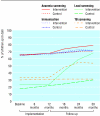Practice based education to improve delivery systems for prevention in primary care: randomised trial
- PMID: 14766718
- PMCID: PMC341391
- DOI: 10.1136/bmj.38009.706319.47
Practice based education to improve delivery systems for prevention in primary care: randomised trial
Abstract
Objective: To examine the effectiveness of an intervention that combined continuing medical education with process improvement methods to implement "office systems" to improve the delivery of preventive care to children.
Design: Randomised trial in primary care practices.
Setting: Private paediatric and family practices in two areas of North Carolina.
Participants: Random sample of 44 practices allocated to intervention and control groups.
Intervention: Practice based continuing medical education in which project staff coached practice staff in reviewing performance and identifying, testing, and implementing new care processes (such as chart screening) to improve delivery of preventive care.
Main outcome measure: Change over time in the proportion of children aged 24-30 months who received age appropriate care for four preventive services (immunisations, and screening for tuberculosis, anaemia, and lead).
Results: The proportion of children per practice with age appropriate delivery of all four preventive services changed, after a one year period of implementation, from 7% to 34% in intervention practices and from 9% to 10% in control practices. After adjustment for baseline differences in the groups, the change in the prevalence of all four services between the beginning and the end of the study was 4.6-fold greater (95% confidence interval 1.6 to 13.2) in intervention practices. Thirty months after baseline, the proportion of children who were up to date with preventive services was higher in intervention than in control practices; results for screening for tuberculosis (54% v 32%), lead (68% v 30%), and anaemia (79% v 71%) were statistically significant (P < 0.05).
Conclusion: Continuing education combined with process improvement methods is effective in increasing rates of delivery of preventive care to children.
Figures



References
-
- Centers for Disease Control. National, state, and urban area vaccination coverage levels among children aged 19-35 months. United States, 2000. MMWR Morb Mortal Wkly Rep 2001;50: 637-41. - PubMed
-
- US Preventive Services Task Force. Guide to clinical preventive services. 3rd ed, 2000-2002. Washington, DC: Office of Disease Prevention and Health Promotion, US Government Printing Office, 2002.
-
- American Academy of Pediatrics, Committee on Practice and Ambulatory Medicine. Recommendations for preventative pediatric health care. Pediatrics 2000;105: 645-6.
-
- Committee on Quality of Health Care in America, Institute of Medicine. Crossing the quality chasm: a new health system for the 21st century. Washington, DC: National Academy Press, 2001.
-
- Leininger LS, Finn L, Dickey L, Dietrich AJ, Foxhall L, Garr D, et al. An office system for organizing preventive services: a report by the American Cancer Society Advisory Group on Preventive Health Care Reminder Systems. Arch Fam Med 1996;5: 108-15. - PubMed
Publication types
MeSH terms
Grants and funding
LinkOut - more resources
Full Text Sources
Medical
